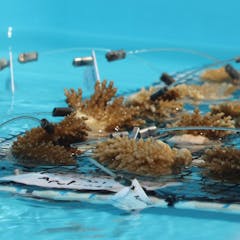
Articles on Corals
Displaying 1 - 20 of 91 articles

Dozens of animals, some on land but many in the ocean, can produce light within their bodies through chemical reactions. Scientists are still trying to understand when and why this trait developed.

Global ocean temperatures have been at record highs almost daily for over a year, and economies are feeling the heat.

Just as the world’s zoos breed critically endangered animals in captivity to repopulate the wild, scientists are building a global effort to freeze corals for reef restoration.

The Great Barrier Reef is facing its worst summer of sustained heat stress since the mass bleaching event of 1998, but now with less time to recover amid repeated brutal conditions.

In the Mediterranean, heat waves are decimating underwater forests that are essential to ecosystems. The gorgonians seem to be better able to resist in the depths, but this refuge may only be temporary.

When ships sink, they add artificial structures to the seafloor that can quickly become diverse, ecologically important underwater communities.

In the vast St. Lawrence River, an impressive variety of animals live on the seabed. This group of organisms is called benthos or benthic invertebrates.

While the Great Barrier Reed needs nutrients to support the ecosystem, it is possible to have too much of a good thing.

After a chance discovery in the lab, this team used IVF to make hundreds of coral babies for restoration projects in New South Wales. So far the IVF babies are doing well in the wild.

Exploring the often unseen, and poorly understood, nuances of diversity within coral reefs may prove essential for ensuring the long-term health of Earth’s oceans.

This may buy us time, but many reefs are still doomed without serious action on climate change.

Ocean temperatures have hit record highs off the Florida Keys. Scientists and volunteer divers are racing to save these valuable creatures.

Water temperatures in the 90s off Florida in July are alarming, a NOAA coral scientist writes. Scientists in several North American countries have already spotted coral bleaching off their coasts.

Evidence in Earth’s natural archives, from tree rings to seafloor sediments, points to one trend. Some climate models suggest another.

Rats are disrupting the flow of nutrients towards the sea on many tropical islands – this has consequences for fish behaviour and the wider ecosystem.

Black corals provide critical habitat for many creatures that live in the dark, often barren, deep sea, and researchers are learning more about these rare corals with every dive.

Establishing the age of K'gari (Fraser Island) confirms it emerged before the reef, despite the climate being suitable for coral growth long before then.

Forming tightly woven populations, these bush-like corals offer a refuge to a myriad of marine species.

Corals in the Persian Gulf are tough - they can withstand temperatures that would kill corals elsewhere. And there’s good news: it’s easy to cross-breed their heat-tolerance genes into other corals.

Researchers found 16% of coral species have not been seen for many years. This finding is alarming, because local extinctions suggest global extinctions may be looming.
